Economics for Business: Demand, Supply, Elasticity, Trade Policies
VerifiedAdded on 2021/12/26
|10
|2331
|31
Report
AI Summary
This report delves into the core economic principles relevant to businesses, examining the concepts of demand, supply, and price elasticity. It explores how these factors influence market dynamics and pricing strategies, using the case of Uber to illustrate dynamic pricing. The report also analyzes the impact of trade policies, specifically protectionist measures like tariffs, on international trade, with a focus on the Australian economy and its comparative advantages in the context of the US-China trade war. It concludes by highlighting the importance of comparative advantage in international trade and the potential effects of trade policies on business relationships. The report provides a comprehensive overview of these economic principles and their practical implications for businesses operating in a globalized market.
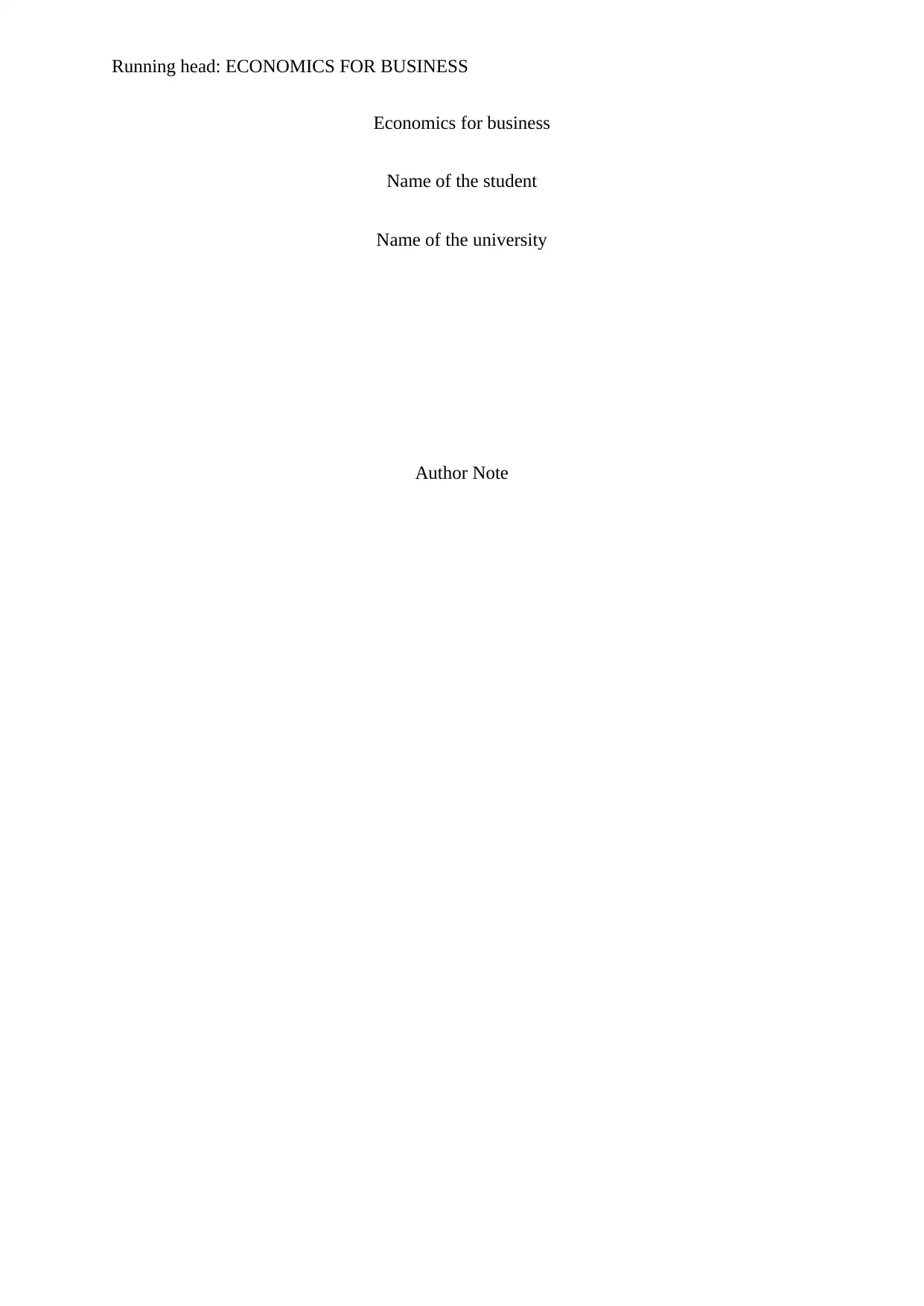
Running head: ECONOMICS FOR BUSINESS
Economics for business
Name of the student
Name of the university
Author Note
Economics for business
Name of the student
Name of the university
Author Note
Paraphrase This Document
Need a fresh take? Get an instant paraphrase of this document with our AI Paraphraser
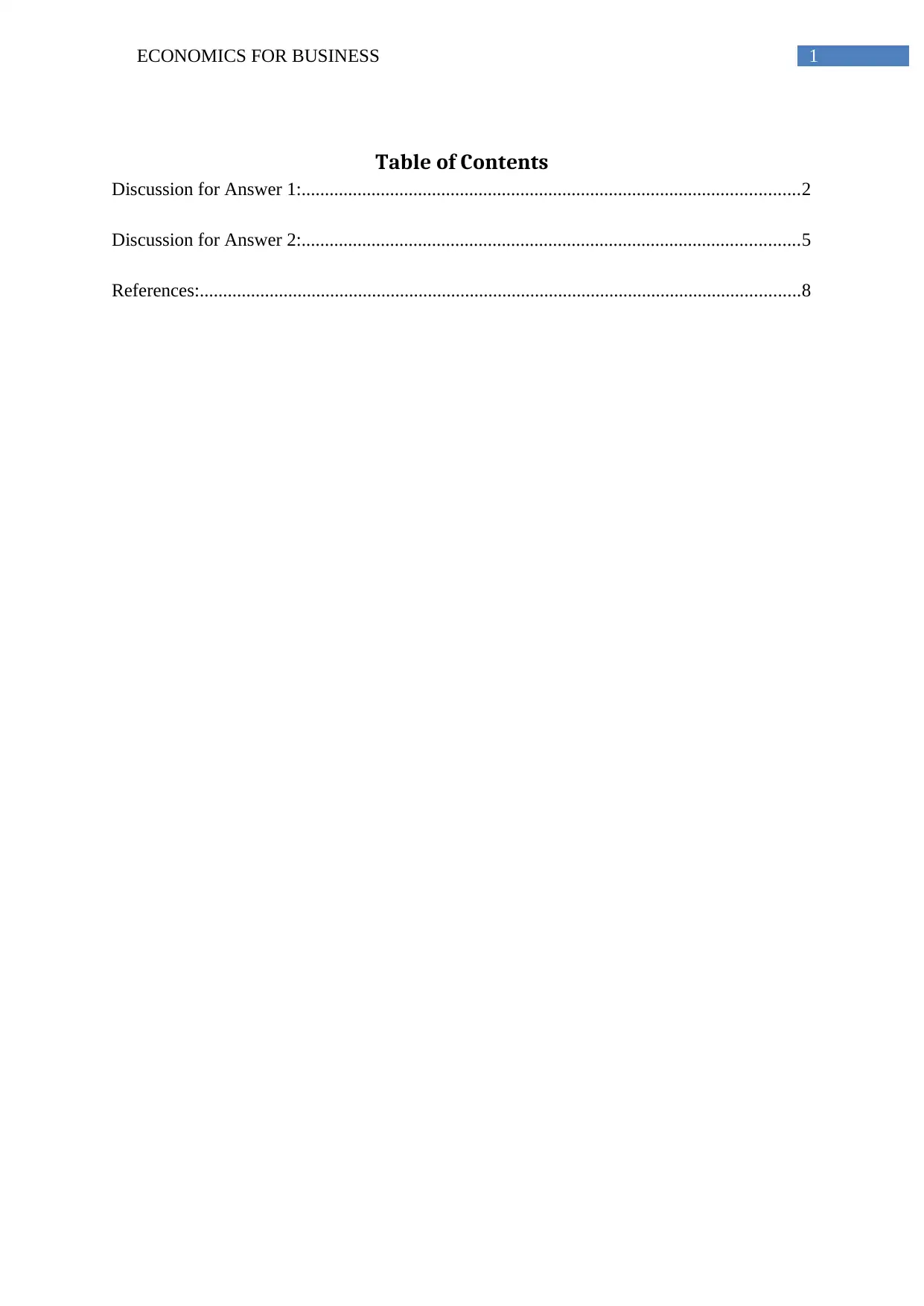
1ECONOMICS FOR BUSINESS
Table of Contents
Discussion for Answer 1:...........................................................................................................2
Discussion for Answer 2:...........................................................................................................5
References:.................................................................................................................................8
Table of Contents
Discussion for Answer 1:...........................................................................................................2
Discussion for Answer 2:...........................................................................................................5
References:.................................................................................................................................8
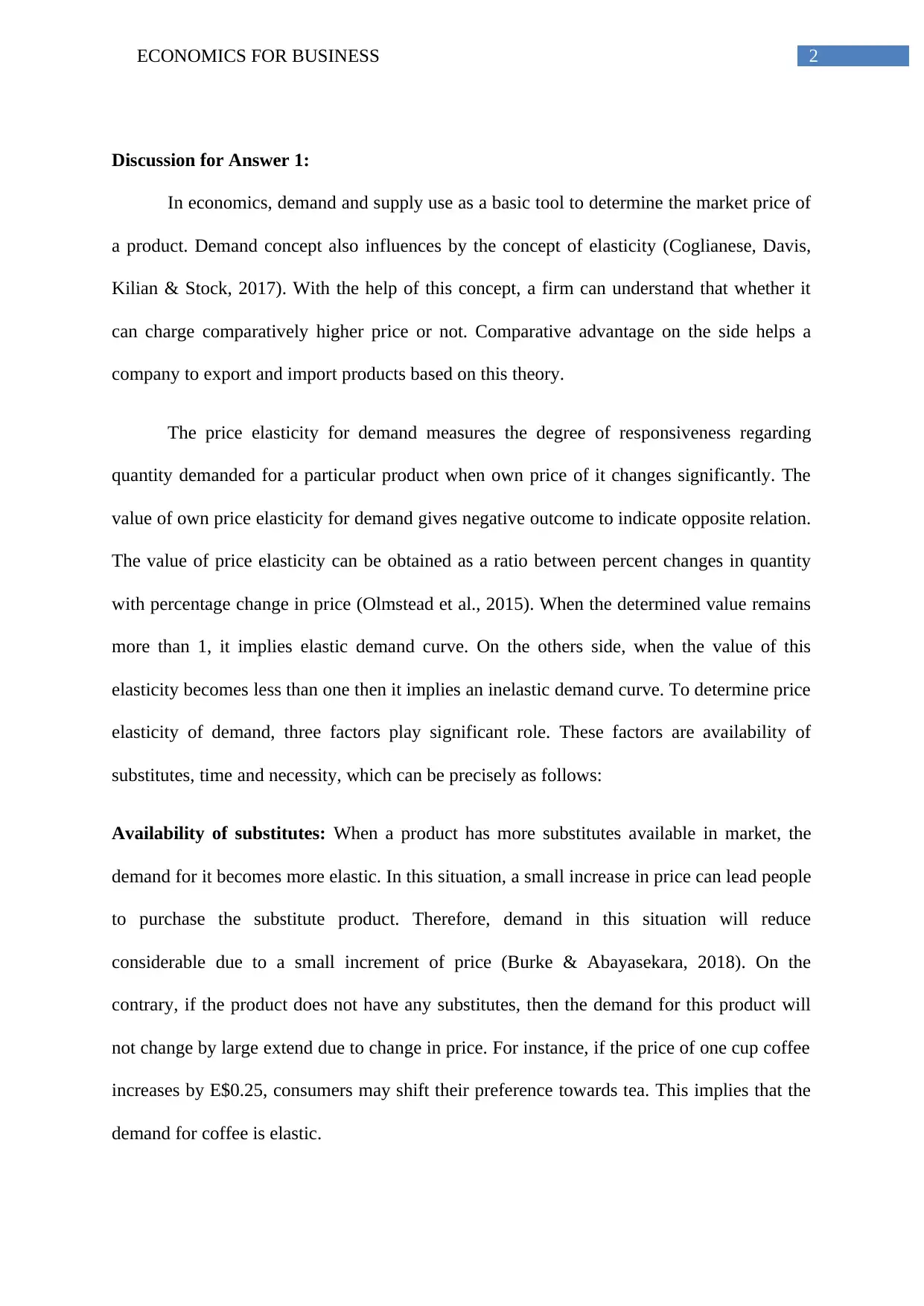
2ECONOMICS FOR BUSINESS
Discussion for Answer 1:
In economics, demand and supply use as a basic tool to determine the market price of
a product. Demand concept also influences by the concept of elasticity (Coglianese, Davis,
Kilian & Stock, 2017). With the help of this concept, a firm can understand that whether it
can charge comparatively higher price or not. Comparative advantage on the side helps a
company to export and import products based on this theory.
The price elasticity for demand measures the degree of responsiveness regarding
quantity demanded for a particular product when own price of it changes significantly. The
value of own price elasticity for demand gives negative outcome to indicate opposite relation.
The value of price elasticity can be obtained as a ratio between percent changes in quantity
with percentage change in price (Olmstead et al., 2015). When the determined value remains
more than 1, it implies elastic demand curve. On the others side, when the value of this
elasticity becomes less than one then it implies an inelastic demand curve. To determine price
elasticity of demand, three factors play significant role. These factors are availability of
substitutes, time and necessity, which can be precisely as follows:
Availability of substitutes: When a product has more substitutes available in market, the
demand for it becomes more elastic. In this situation, a small increase in price can lead people
to purchase the substitute product. Therefore, demand in this situation will reduce
considerable due to a small increment of price (Burke & Abayasekara, 2018). On the
contrary, if the product does not have any substitutes, then the demand for this product will
not change by large extend due to change in price. For instance, if the price of one cup coffee
increases by E$0.25, consumers may shift their preference towards tea. This implies that the
demand for coffee is elastic.
Discussion for Answer 1:
In economics, demand and supply use as a basic tool to determine the market price of
a product. Demand concept also influences by the concept of elasticity (Coglianese, Davis,
Kilian & Stock, 2017). With the help of this concept, a firm can understand that whether it
can charge comparatively higher price or not. Comparative advantage on the side helps a
company to export and import products based on this theory.
The price elasticity for demand measures the degree of responsiveness regarding
quantity demanded for a particular product when own price of it changes significantly. The
value of own price elasticity for demand gives negative outcome to indicate opposite relation.
The value of price elasticity can be obtained as a ratio between percent changes in quantity
with percentage change in price (Olmstead et al., 2015). When the determined value remains
more than 1, it implies elastic demand curve. On the others side, when the value of this
elasticity becomes less than one then it implies an inelastic demand curve. To determine price
elasticity of demand, three factors play significant role. These factors are availability of
substitutes, time and necessity, which can be precisely as follows:
Availability of substitutes: When a product has more substitutes available in market, the
demand for it becomes more elastic. In this situation, a small increase in price can lead people
to purchase the substitute product. Therefore, demand in this situation will reduce
considerable due to a small increment of price (Burke & Abayasekara, 2018). On the
contrary, if the product does not have any substitutes, then the demand for this product will
not change by large extend due to change in price. For instance, if the price of one cup coffee
increases by E$0.25, consumers may shift their preference towards tea. This implies that the
demand for coffee is elastic.
⊘ This is a preview!⊘
Do you want full access?
Subscribe today to unlock all pages.

Trusted by 1+ million students worldwide
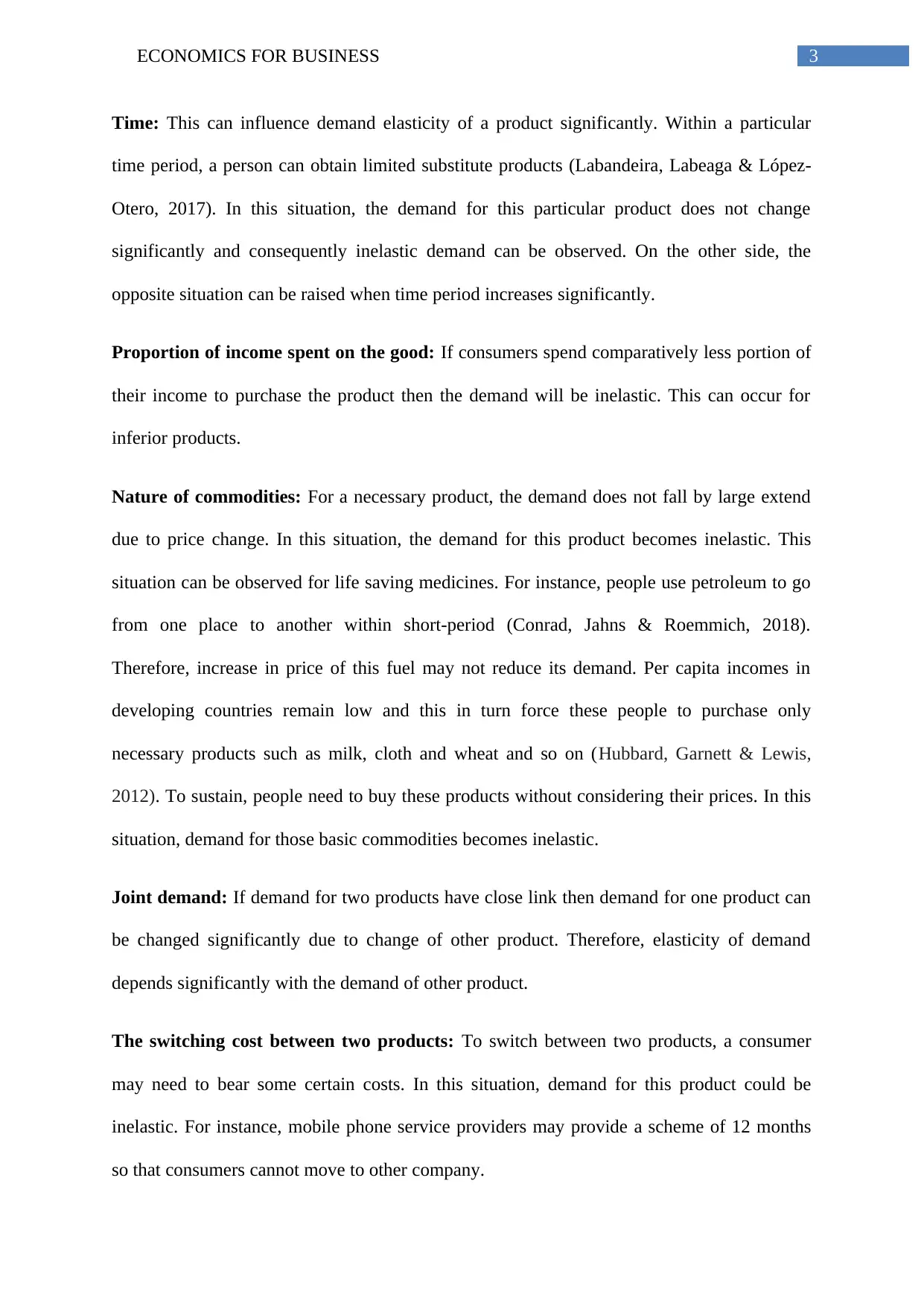
3ECONOMICS FOR BUSINESS
Time: This can influence demand elasticity of a product significantly. Within a particular
time period, a person can obtain limited substitute products (Labandeira, Labeaga & López-
Otero, 2017). In this situation, the demand for this particular product does not change
significantly and consequently inelastic demand can be observed. On the other side, the
opposite situation can be raised when time period increases significantly.
Proportion of income spent on the good: If consumers spend comparatively less portion of
their income to purchase the product then the demand will be inelastic. This can occur for
inferior products.
Nature of commodities: For a necessary product, the demand does not fall by large extend
due to price change. In this situation, the demand for this product becomes inelastic. This
situation can be observed for life saving medicines. For instance, people use petroleum to go
from one place to another within short-period (Conrad, Jahns & Roemmich, 2018).
Therefore, increase in price of this fuel may not reduce its demand. Per capita incomes in
developing countries remain low and this in turn force these people to purchase only
necessary products such as milk, cloth and wheat and so on (Hubbard, Garnett & Lewis,
2012). To sustain, people need to buy these products without considering their prices. In this
situation, demand for those basic commodities becomes inelastic.
Joint demand: If demand for two products have close link then demand for one product can
be changed significantly due to change of other product. Therefore, elasticity of demand
depends significantly with the demand of other product.
The switching cost between two products: To switch between two products, a consumer
may need to bear some certain costs. In this situation, demand for this product could be
inelastic. For instance, mobile phone service providers may provide a scheme of 12 months
so that consumers cannot move to other company.
Time: This can influence demand elasticity of a product significantly. Within a particular
time period, a person can obtain limited substitute products (Labandeira, Labeaga & López-
Otero, 2017). In this situation, the demand for this particular product does not change
significantly and consequently inelastic demand can be observed. On the other side, the
opposite situation can be raised when time period increases significantly.
Proportion of income spent on the good: If consumers spend comparatively less portion of
their income to purchase the product then the demand will be inelastic. This can occur for
inferior products.
Nature of commodities: For a necessary product, the demand does not fall by large extend
due to price change. In this situation, the demand for this product becomes inelastic. This
situation can be observed for life saving medicines. For instance, people use petroleum to go
from one place to another within short-period (Conrad, Jahns & Roemmich, 2018).
Therefore, increase in price of this fuel may not reduce its demand. Per capita incomes in
developing countries remain low and this in turn force these people to purchase only
necessary products such as milk, cloth and wheat and so on (Hubbard, Garnett & Lewis,
2012). To sustain, people need to buy these products without considering their prices. In this
situation, demand for those basic commodities becomes inelastic.
Joint demand: If demand for two products have close link then demand for one product can
be changed significantly due to change of other product. Therefore, elasticity of demand
depends significantly with the demand of other product.
The switching cost between two products: To switch between two products, a consumer
may need to bear some certain costs. In this situation, demand for this product could be
inelastic. For instance, mobile phone service providers may provide a scheme of 12 months
so that consumers cannot move to other company.
Paraphrase This Document
Need a fresh take? Get an instant paraphrase of this document with our AI Paraphraser
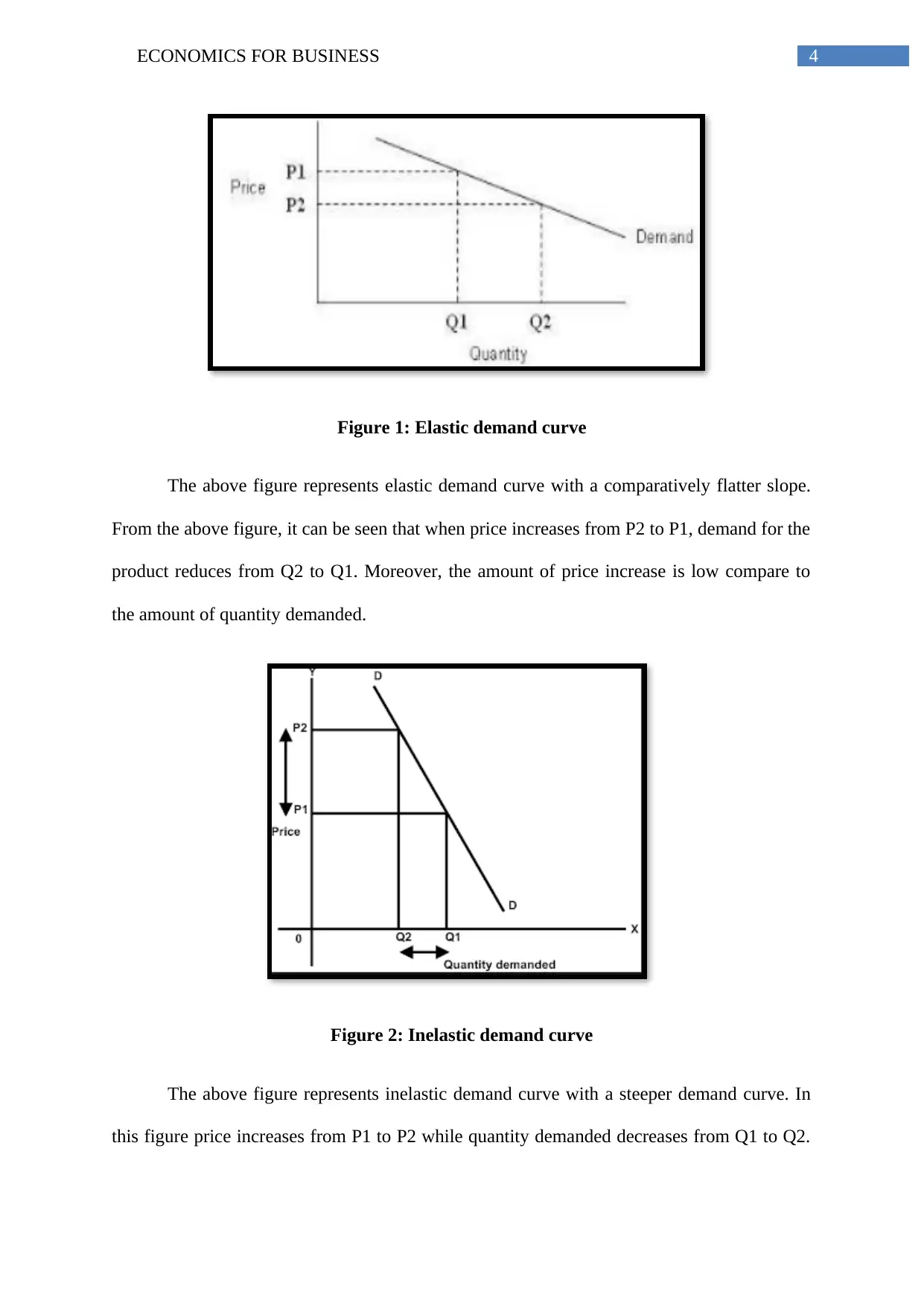
4ECONOMICS FOR BUSINESS
Figure 1: Elastic demand curve
The above figure represents elastic demand curve with a comparatively flatter slope.
From the above figure, it can be seen that when price increases from P2 to P1, demand for the
product reduces from Q2 to Q1. Moreover, the amount of price increase is low compare to
the amount of quantity demanded.
Figure 2: Inelastic demand curve
The above figure represents inelastic demand curve with a steeper demand curve. In
this figure price increases from P1 to P2 while quantity demanded decreases from Q1 to Q2.
Figure 1: Elastic demand curve
The above figure represents elastic demand curve with a comparatively flatter slope.
From the above figure, it can be seen that when price increases from P2 to P1, demand for the
product reduces from Q2 to Q1. Moreover, the amount of price increase is low compare to
the amount of quantity demanded.
Figure 2: Inelastic demand curve
The above figure represents inelastic demand curve with a steeper demand curve. In
this figure price increases from P1 to P2 while quantity demanded decreases from Q1 to Q2.
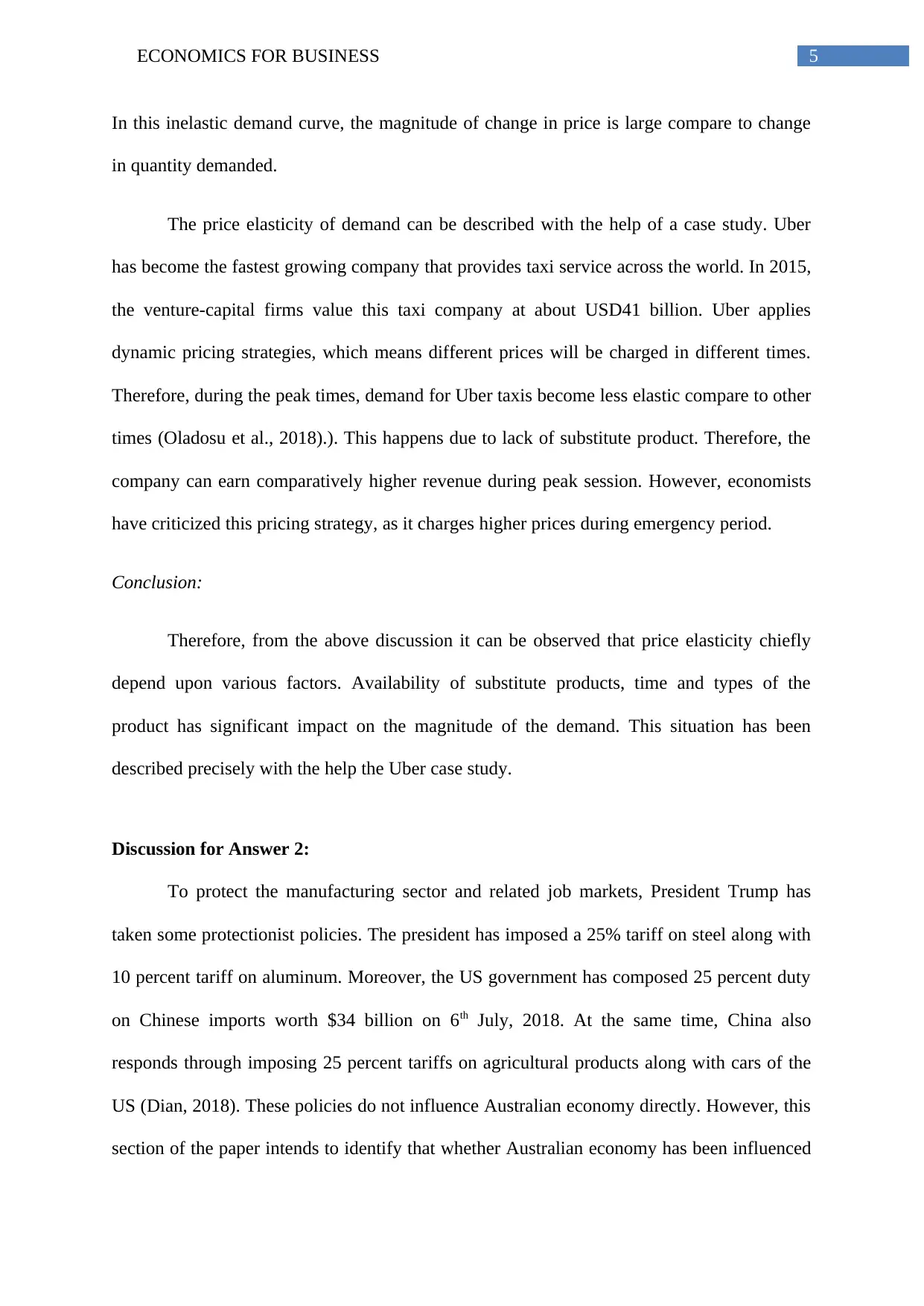
5ECONOMICS FOR BUSINESS
In this inelastic demand curve, the magnitude of change in price is large compare to change
in quantity demanded.
The price elasticity of demand can be described with the help of a case study. Uber
has become the fastest growing company that provides taxi service across the world. In 2015,
the venture-capital firms value this taxi company at about USD41 billion. Uber applies
dynamic pricing strategies, which means different prices will be charged in different times.
Therefore, during the peak times, demand for Uber taxis become less elastic compare to other
times (Oladosu et al., 2018).). This happens due to lack of substitute product. Therefore, the
company can earn comparatively higher revenue during peak session. However, economists
have criticized this pricing strategy, as it charges higher prices during emergency period.
Conclusion:
Therefore, from the above discussion it can be observed that price elasticity chiefly
depend upon various factors. Availability of substitute products, time and types of the
product has significant impact on the magnitude of the demand. This situation has been
described precisely with the help the Uber case study.
Discussion for Answer 2:
To protect the manufacturing sector and related job markets, President Trump has
taken some protectionist policies. The president has imposed a 25% tariff on steel along with
10 percent tariff on aluminum. Moreover, the US government has composed 25 percent duty
on Chinese imports worth $34 billion on 6th July, 2018. At the same time, China also
responds through imposing 25 percent tariffs on agricultural products along with cars of the
US (Dian, 2018). These policies do not influence Australian economy directly. However, this
section of the paper intends to identify that whether Australian economy has been influenced
In this inelastic demand curve, the magnitude of change in price is large compare to change
in quantity demanded.
The price elasticity of demand can be described with the help of a case study. Uber
has become the fastest growing company that provides taxi service across the world. In 2015,
the venture-capital firms value this taxi company at about USD41 billion. Uber applies
dynamic pricing strategies, which means different prices will be charged in different times.
Therefore, during the peak times, demand for Uber taxis become less elastic compare to other
times (Oladosu et al., 2018).). This happens due to lack of substitute product. Therefore, the
company can earn comparatively higher revenue during peak session. However, economists
have criticized this pricing strategy, as it charges higher prices during emergency period.
Conclusion:
Therefore, from the above discussion it can be observed that price elasticity chiefly
depend upon various factors. Availability of substitute products, time and types of the
product has significant impact on the magnitude of the demand. This situation has been
described precisely with the help the Uber case study.
Discussion for Answer 2:
To protect the manufacturing sector and related job markets, President Trump has
taken some protectionist policies. The president has imposed a 25% tariff on steel along with
10 percent tariff on aluminum. Moreover, the US government has composed 25 percent duty
on Chinese imports worth $34 billion on 6th July, 2018. At the same time, China also
responds through imposing 25 percent tariffs on agricultural products along with cars of the
US (Dian, 2018). These policies do not influence Australian economy directly. However, this
section of the paper intends to identify that whether Australian economy has been influenced
⊘ This is a preview!⊘
Do you want full access?
Subscribe today to unlock all pages.

Trusted by 1+ million students worldwide
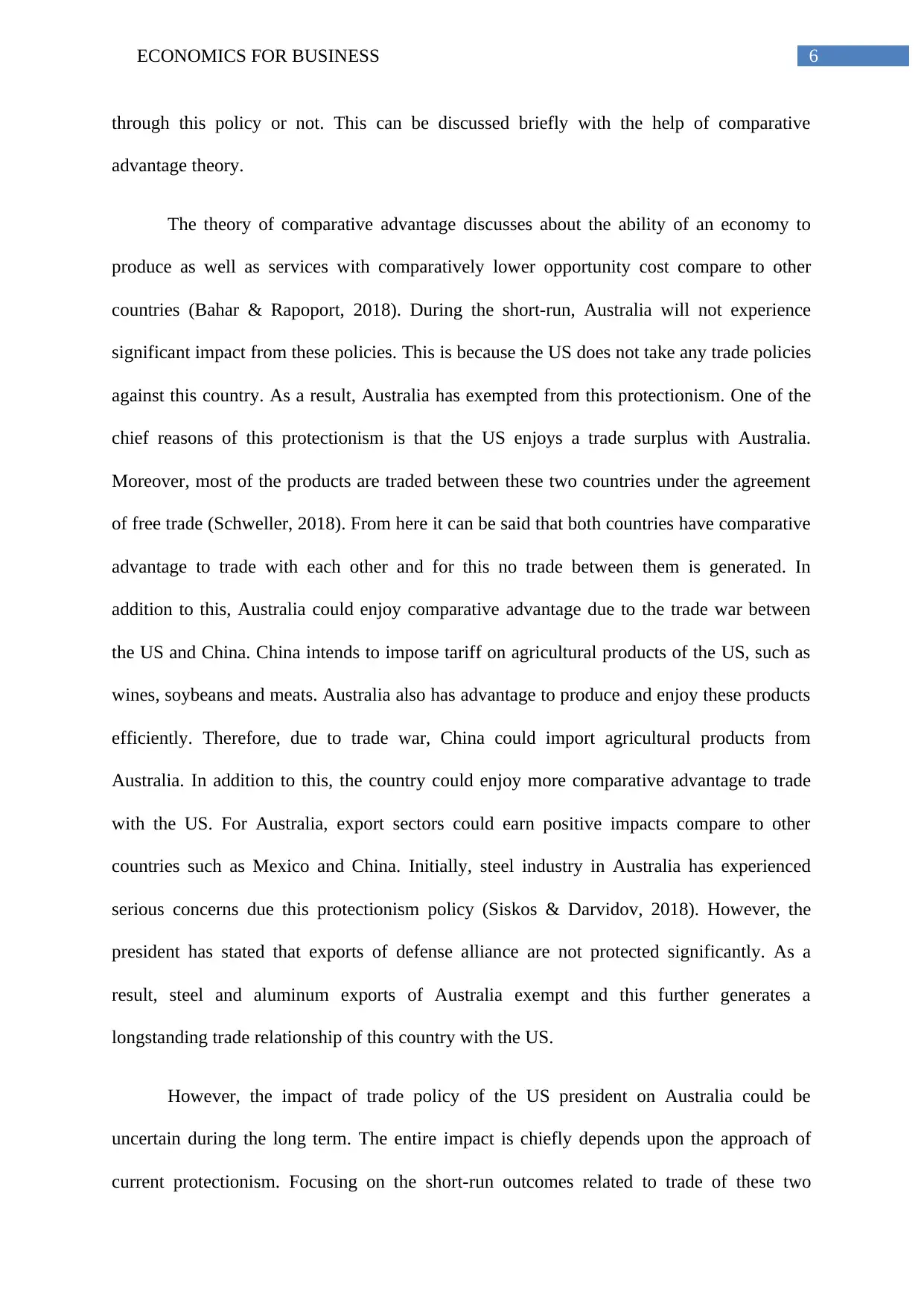
6ECONOMICS FOR BUSINESS
through this policy or not. This can be discussed briefly with the help of comparative
advantage theory.
The theory of comparative advantage discusses about the ability of an economy to
produce as well as services with comparatively lower opportunity cost compare to other
countries (Bahar & Rapoport, 2018). During the short-run, Australia will not experience
significant impact from these policies. This is because the US does not take any trade policies
against this country. As a result, Australia has exempted from this protectionism. One of the
chief reasons of this protectionism is that the US enjoys a trade surplus with Australia.
Moreover, most of the products are traded between these two countries under the agreement
of free trade (Schweller, 2018). From here it can be said that both countries have comparative
advantage to trade with each other and for this no trade between them is generated. In
addition to this, Australia could enjoy comparative advantage due to the trade war between
the US and China. China intends to impose tariff on agricultural products of the US, such as
wines, soybeans and meats. Australia also has advantage to produce and enjoy these products
efficiently. Therefore, due to trade war, China could import agricultural products from
Australia. In addition to this, the country could enjoy more comparative advantage to trade
with the US. For Australia, export sectors could earn positive impacts compare to other
countries such as Mexico and China. Initially, steel industry in Australia has experienced
serious concerns due this protectionism policy (Siskos & Darvidov, 2018). However, the
president has stated that exports of defense alliance are not protected significantly. As a
result, steel and aluminum exports of Australia exempt and this further generates a
longstanding trade relationship of this country with the US.
However, the impact of trade policy of the US president on Australia could be
uncertain during the long term. The entire impact is chiefly depends upon the approach of
current protectionism. Focusing on the short-run outcomes related to trade of these two
through this policy or not. This can be discussed briefly with the help of comparative
advantage theory.
The theory of comparative advantage discusses about the ability of an economy to
produce as well as services with comparatively lower opportunity cost compare to other
countries (Bahar & Rapoport, 2018). During the short-run, Australia will not experience
significant impact from these policies. This is because the US does not take any trade policies
against this country. As a result, Australia has exempted from this protectionism. One of the
chief reasons of this protectionism is that the US enjoys a trade surplus with Australia.
Moreover, most of the products are traded between these two countries under the agreement
of free trade (Schweller, 2018). From here it can be said that both countries have comparative
advantage to trade with each other and for this no trade between them is generated. In
addition to this, Australia could enjoy comparative advantage due to the trade war between
the US and China. China intends to impose tariff on agricultural products of the US, such as
wines, soybeans and meats. Australia also has advantage to produce and enjoy these products
efficiently. Therefore, due to trade war, China could import agricultural products from
Australia. In addition to this, the country could enjoy more comparative advantage to trade
with the US. For Australia, export sectors could earn positive impacts compare to other
countries such as Mexico and China. Initially, steel industry in Australia has experienced
serious concerns due this protectionism policy (Siskos & Darvidov, 2018). However, the
president has stated that exports of defense alliance are not protected significantly. As a
result, steel and aluminum exports of Australia exempt and this further generates a
longstanding trade relationship of this country with the US.
However, the impact of trade policy of the US president on Australia could be
uncertain during the long term. The entire impact is chiefly depends upon the approach of
current protectionism. Focusing on the short-run outcomes related to trade of these two
Paraphrase This Document
Need a fresh take? Get an instant paraphrase of this document with our AI Paraphraser
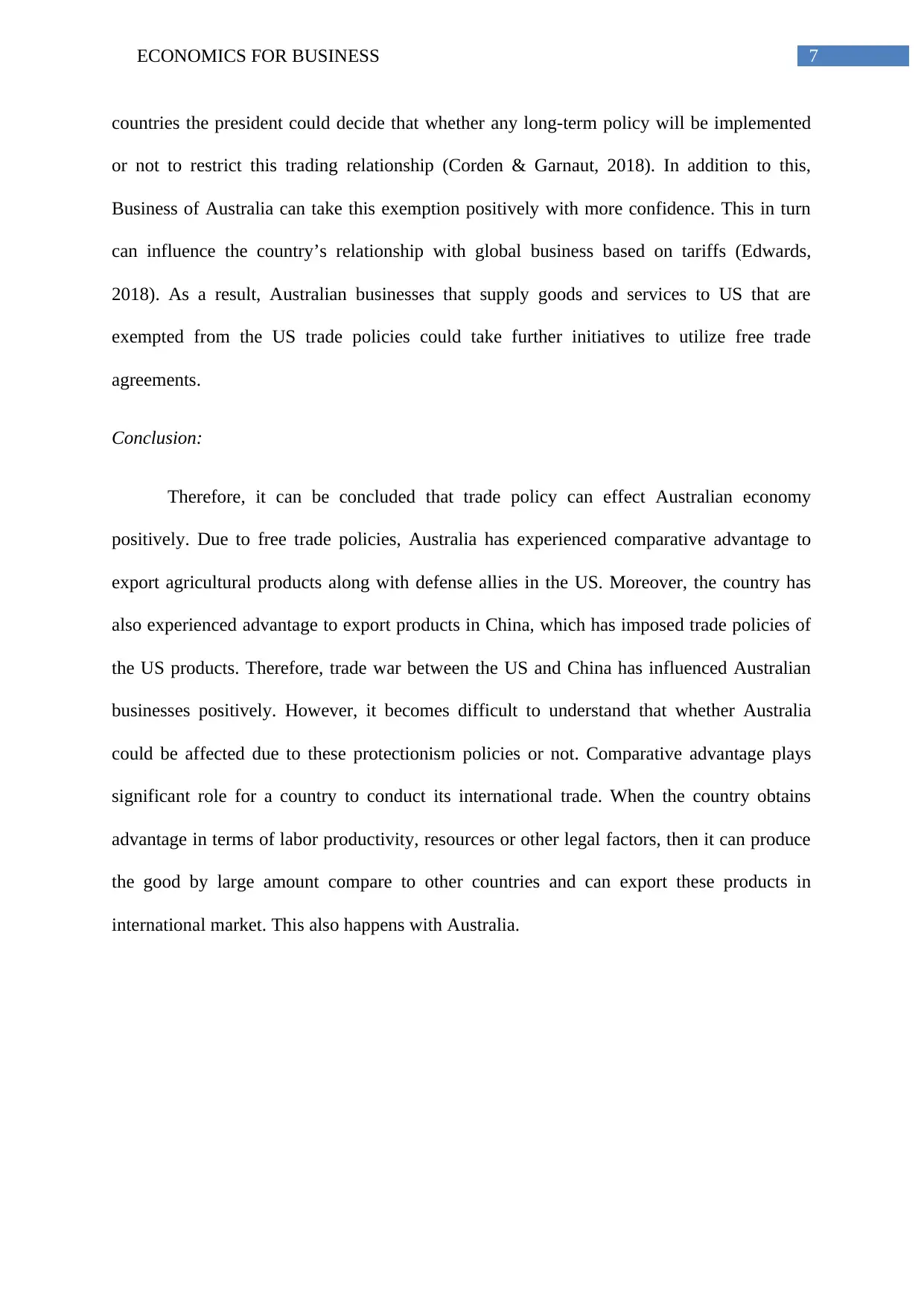
7ECONOMICS FOR BUSINESS
countries the president could decide that whether any long-term policy will be implemented
or not to restrict this trading relationship (Corden & Garnaut, 2018). In addition to this,
Business of Australia can take this exemption positively with more confidence. This in turn
can influence the country’s relationship with global business based on tariffs (Edwards,
2018). As a result, Australian businesses that supply goods and services to US that are
exempted from the US trade policies could take further initiatives to utilize free trade
agreements.
Conclusion:
Therefore, it can be concluded that trade policy can effect Australian economy
positively. Due to free trade policies, Australia has experienced comparative advantage to
export agricultural products along with defense allies in the US. Moreover, the country has
also experienced advantage to export products in China, which has imposed trade policies of
the US products. Therefore, trade war between the US and China has influenced Australian
businesses positively. However, it becomes difficult to understand that whether Australia
could be affected due to these protectionism policies or not. Comparative advantage plays
significant role for a country to conduct its international trade. When the country obtains
advantage in terms of labor productivity, resources or other legal factors, then it can produce
the good by large amount compare to other countries and can export these products in
international market. This also happens with Australia.
countries the president could decide that whether any long-term policy will be implemented
or not to restrict this trading relationship (Corden & Garnaut, 2018). In addition to this,
Business of Australia can take this exemption positively with more confidence. This in turn
can influence the country’s relationship with global business based on tariffs (Edwards,
2018). As a result, Australian businesses that supply goods and services to US that are
exempted from the US trade policies could take further initiatives to utilize free trade
agreements.
Conclusion:
Therefore, it can be concluded that trade policy can effect Australian economy
positively. Due to free trade policies, Australia has experienced comparative advantage to
export agricultural products along with defense allies in the US. Moreover, the country has
also experienced advantage to export products in China, which has imposed trade policies of
the US products. Therefore, trade war between the US and China has influenced Australian
businesses positively. However, it becomes difficult to understand that whether Australia
could be affected due to these protectionism policies or not. Comparative advantage plays
significant role for a country to conduct its international trade. When the country obtains
advantage in terms of labor productivity, resources or other legal factors, then it can produce
the good by large amount compare to other countries and can export these products in
international market. This also happens with Australia.
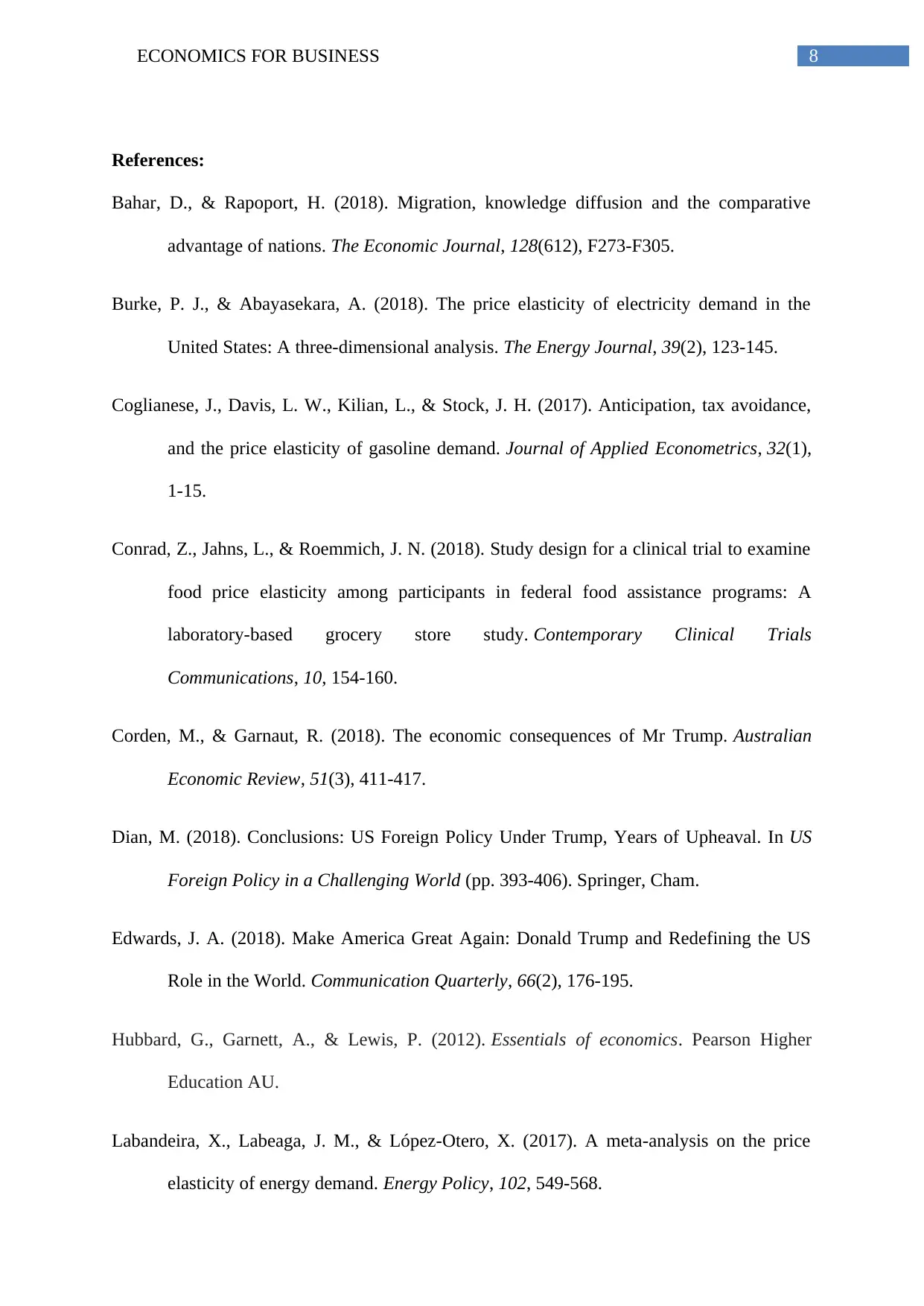
8ECONOMICS FOR BUSINESS
References:
Bahar, D., & Rapoport, H. (2018). Migration, knowledge diffusion and the comparative
advantage of nations. The Economic Journal, 128(612), F273-F305.
Burke, P. J., & Abayasekara, A. (2018). The price elasticity of electricity demand in the
United States: A three-dimensional analysis. The Energy Journal, 39(2), 123-145.
Coglianese, J., Davis, L. W., Kilian, L., & Stock, J. H. (2017). Anticipation, tax avoidance,
and the price elasticity of gasoline demand. Journal of Applied Econometrics, 32(1),
1-15.
Conrad, Z., Jahns, L., & Roemmich, J. N. (2018). Study design for a clinical trial to examine
food price elasticity among participants in federal food assistance programs: A
laboratory-based grocery store study. Contemporary Clinical Trials
Communications, 10, 154-160.
Corden, M., & Garnaut, R. (2018). The economic consequences of Mr Trump. Australian
Economic Review, 51(3), 411-417.
Dian, M. (2018). Conclusions: US Foreign Policy Under Trump, Years of Upheaval. In US
Foreign Policy in a Challenging World (pp. 393-406). Springer, Cham.
Edwards, J. A. (2018). Make America Great Again: Donald Trump and Redefining the US
Role in the World. Communication Quarterly, 66(2), 176-195.
Hubbard, G., Garnett, A., & Lewis, P. (2012). Essentials of economics. Pearson Higher
Education AU.
Labandeira, X., Labeaga, J. M., & López-Otero, X. (2017). A meta-analysis on the price
elasticity of energy demand. Energy Policy, 102, 549-568.
References:
Bahar, D., & Rapoport, H. (2018). Migration, knowledge diffusion and the comparative
advantage of nations. The Economic Journal, 128(612), F273-F305.
Burke, P. J., & Abayasekara, A. (2018). The price elasticity of electricity demand in the
United States: A three-dimensional analysis. The Energy Journal, 39(2), 123-145.
Coglianese, J., Davis, L. W., Kilian, L., & Stock, J. H. (2017). Anticipation, tax avoidance,
and the price elasticity of gasoline demand. Journal of Applied Econometrics, 32(1),
1-15.
Conrad, Z., Jahns, L., & Roemmich, J. N. (2018). Study design for a clinical trial to examine
food price elasticity among participants in federal food assistance programs: A
laboratory-based grocery store study. Contemporary Clinical Trials
Communications, 10, 154-160.
Corden, M., & Garnaut, R. (2018). The economic consequences of Mr Trump. Australian
Economic Review, 51(3), 411-417.
Dian, M. (2018). Conclusions: US Foreign Policy Under Trump, Years of Upheaval. In US
Foreign Policy in a Challenging World (pp. 393-406). Springer, Cham.
Edwards, J. A. (2018). Make America Great Again: Donald Trump and Redefining the US
Role in the World. Communication Quarterly, 66(2), 176-195.
Hubbard, G., Garnett, A., & Lewis, P. (2012). Essentials of economics. Pearson Higher
Education AU.
Labandeira, X., Labeaga, J. M., & López-Otero, X. (2017). A meta-analysis on the price
elasticity of energy demand. Energy Policy, 102, 549-568.
⊘ This is a preview!⊘
Do you want full access?
Subscribe today to unlock all pages.

Trusted by 1+ million students worldwide
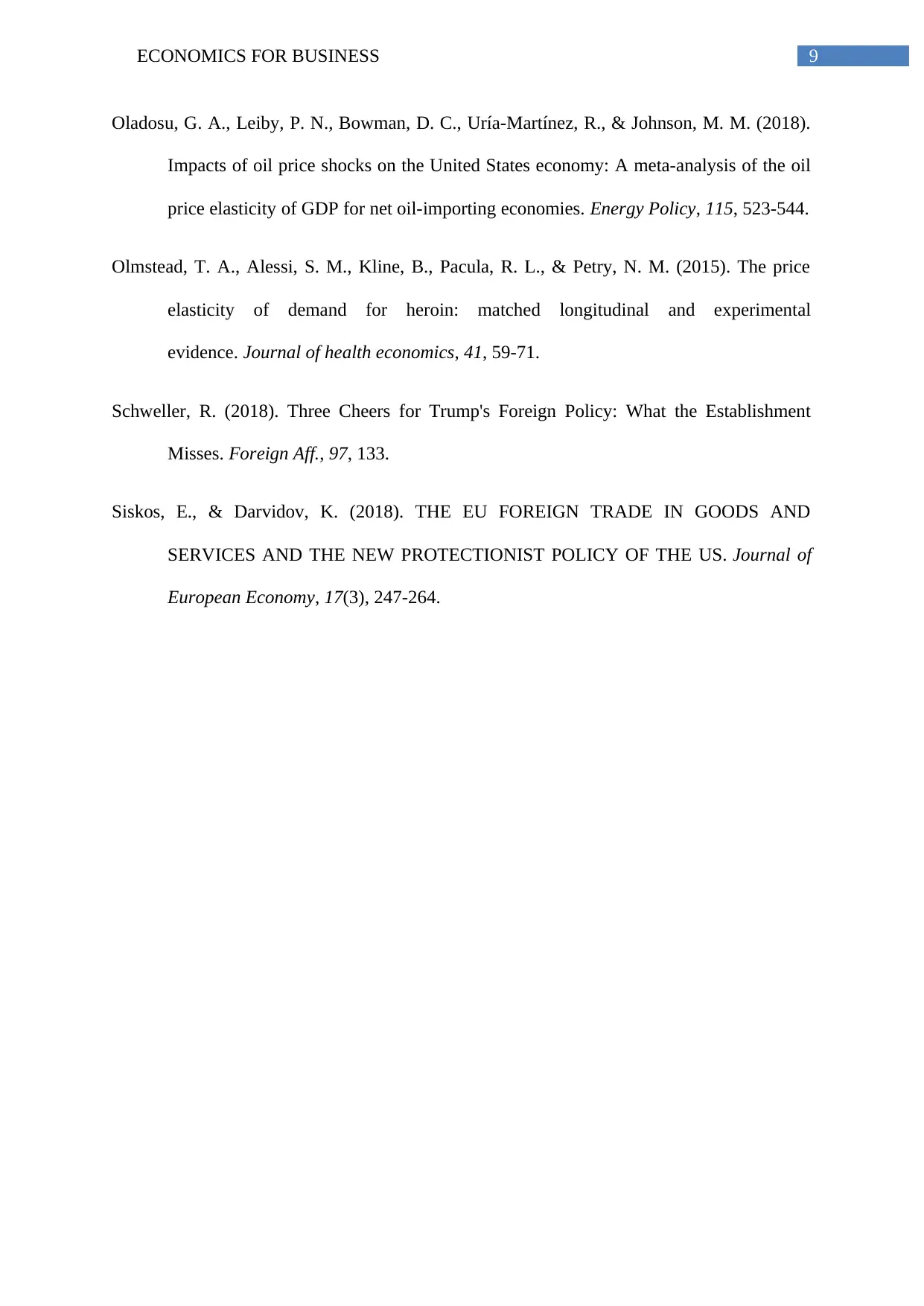
9ECONOMICS FOR BUSINESS
Oladosu, G. A., Leiby, P. N., Bowman, D. C., Uría-Martínez, R., & Johnson, M. M. (2018).
Impacts of oil price shocks on the United States economy: A meta-analysis of the oil
price elasticity of GDP for net oil-importing economies. Energy Policy, 115, 523-544.
Olmstead, T. A., Alessi, S. M., Kline, B., Pacula, R. L., & Petry, N. M. (2015). The price
elasticity of demand for heroin: matched longitudinal and experimental
evidence. Journal of health economics, 41, 59-71.
Schweller, R. (2018). Three Cheers for Trump's Foreign Policy: What the Establishment
Misses. Foreign Aff., 97, 133.
Siskos, E., & Darvidov, K. (2018). THE EU FOREIGN TRADE IN GOODS AND
SERVICES AND THE NEW PROTECTIONIST POLICY OF THE US. Journal of
European Economy, 17(3), 247-264.
Oladosu, G. A., Leiby, P. N., Bowman, D. C., Uría-Martínez, R., & Johnson, M. M. (2018).
Impacts of oil price shocks on the United States economy: A meta-analysis of the oil
price elasticity of GDP for net oil-importing economies. Energy Policy, 115, 523-544.
Olmstead, T. A., Alessi, S. M., Kline, B., Pacula, R. L., & Petry, N. M. (2015). The price
elasticity of demand for heroin: matched longitudinal and experimental
evidence. Journal of health economics, 41, 59-71.
Schweller, R. (2018). Three Cheers for Trump's Foreign Policy: What the Establishment
Misses. Foreign Aff., 97, 133.
Siskos, E., & Darvidov, K. (2018). THE EU FOREIGN TRADE IN GOODS AND
SERVICES AND THE NEW PROTECTIONIST POLICY OF THE US. Journal of
European Economy, 17(3), 247-264.
1 out of 10
Related Documents
Your All-in-One AI-Powered Toolkit for Academic Success.
+13062052269
info@desklib.com
Available 24*7 on WhatsApp / Email
![[object Object]](/_next/static/media/star-bottom.7253800d.svg)
Unlock your academic potential
Copyright © 2020–2025 A2Z Services. All Rights Reserved. Developed and managed by ZUCOL.





